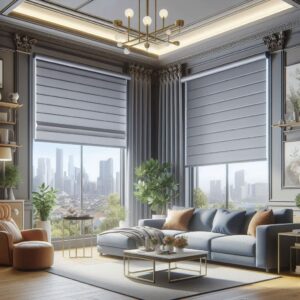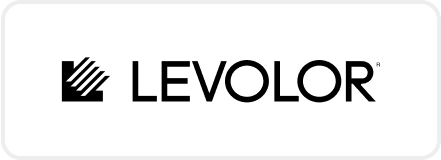Energy costs are soaring, and everyone’s feeling the pinch. But did you know that something as simple as your choice of window treatments can make a huge difference in cutting those costs? Window treatments aren’t just about style; they play a crucial role in your home’s energy efficiency.
In this post, we’ll explore various smart solutions for window treatments that can help keep your home comfortable while slashing your energy bills. We’ll look at options that not only boost your home’s aesthetic appeal but also offer real savings. So whether you’re battling the summer heat or keeping out the winter chill, we’ve got you covered. Get ready to discover the best window treatments to keep your wallet happy and your home cozy year-round.
Why Window Treatments Matter for Energy Efficiency
When it comes to making your home more energy-efficient, window treatments can be a game-changer. You might think that curtains, blinds, or shades are just for privacy and decoration, but they do so much more. The right window treatments can help keep your home warm in the winter and cool in the summer. In the long run, they can lead to lower energy bills, making them a smart investment for any homeowner. Let’s dive into why window treatments are crucial for energy efficiency.

The Science Behind Window Treatments and Energy Savings
Window treatments use a variety of materials and technologies to boost energy savings. These include thermal insulation and light control. Here’s how they work:
- Thermal Insulation: Just like wearing a coat keeps you warm, certain window treatments provide an extra layer of insulation for your windows. Thick curtains, cellular shades, and thermal blinds trap air between the window and the room, creating a barrier that reduces heat loss in winter and heat gain in summer.
- Light Control: Direct sunlight can heat up your home, leading to higher cooling costs in the summer. By controlling the amount of light that enters through the windows, treatments like blackout curtains, reflective blinds, or solar shades can help keep your indoor temperature stable.
Materials like aluminum, polyester, and vinyl are often used in high-efficiency window treatments. Some advanced options even come with coatings that reflect heat. By choosing the right materials and designs, you can significantly improve your home’s energy efficiency.
Common Energy Loss Points in Windows
Identify the areas where energy loss typically occurs can help you understand why window treatments are so effective. Here are the common points where energy loss happens in windows:
- Drafty Seals: Over time, the seals around windows can degrade, allowing cold air in during the winter and letting out cool air in the summer.
- Single-Pane Glass: Many older windows have single-pane glass, which is less effective at insulating compared to double or triple-pane options.
- Heat Transfer: Glass naturally conducts heat, meaning warmth from inside can escape during winter, and heat from outside can enter during summer.
Window treatments can help mitigate these energy losses in several ways:
- Sealing Drafts: Heavier drapes and layered treatments can block drafts, acting as a secondary barrier against the elements.
- Improving Insulation: Cellular shades are particularly good at adding insulation, thanks to their honeycomb structure that traps air.
- Reflecting Heat: Reflective blinds and solar shades can bounce sunlight away, keeping rooms cooler without blocking out all the light.
By addressing these common energy loss points, the right window treatments can make your home more comfortable and greatly reduce your energy bills. Now that you understand why window treatments matter for energy efficiency, you’re better equipped to choose the best options for your home.
Types of Window Treatments for Energy Efficiency
When it comes to cutting down your energy bills, choosing the right window treatments is essential. Different types of treatments offer various benefits. Below, we explore some of the most effective types for energy efficiency.
Cellular Shades
Cellular shades, also known as honeycomb shades, are a fantastic option for energy savings. These shades are designed with a unique honeycomb structure that traps air within pockets. This trapped air adds an extra layer of insulation, helping to keep your home warm in the winter and cool in the summer.
Energy-saving benefits of cellular shades include:
- Insulation: The honeycomb structure reduces heat transfer through your windows.
- Variety: Available in single, double, or even triple cell designs for varying levels of insulation.
- Customization: Options include light-filtering or blackout fabrics for added light control.
If you’re looking for window treatments that provide excellent insulation and help reduce your energy bills, cellular shades are a solid choice.
Thermal Curtains
Thermal curtains go beyond the aesthetic appeal of standard curtains by offering excellent insulating properties. These curtains are made from multiple layers of thick material that help maintain indoor temperatures.
How thermal curtains help:
- Insulation: They create a barrier that prevents heat from escaping during the winter and blocks heat from entering during the summer.
- Versatility: Available in various styles and colors to match any decor.
- Cost-effective: Often more affordable than other insulation methods, like installing new windows.
By keeping the cold air out and the warm air in (or vice versa), thermal curtains can significantly lower your heating and cooling costs.
Solar Shades
Solar shades are another smart solution for improving your home’s energy efficiency. These shades are designed to block UV rays and reduce heat gain, making them perfect for sunny climates.
Benefits of solar shades:
- UV Protection: Blocks up to 90% of harmful ultraviolet rays, preventing furniture and flooring from fading.
- Heat Reduction: Reduces solar heat gain, keeping your home cooler and reducing the need for air conditioning.
- Visibility: Allows you to maintain your view while still blocking out intense sunlight.
If you live in a hot climate or have rooms that get a lot of direct sunlight, solar shades can make a big difference in your energy consumption.
Window Films
Window films are an often-overlooked yet highly effective option for improving energy efficiency. These thin films are applied directly to your window glass and offer several benefits.
Advantages of window films:
- Heat Reflection: Reflects a significant amount of incoming solar heat, keeping your home cooler.
- UV Protection: Blocks up to 99% of UV rays, protecting your interior from sun damage.
- Cost-effective: A more affordable option compared to replacing windows, it’s a quick and easy way to enhance energy efficiency.
By reflecting heat and blocking UV rays, window films can help maintain a comfortable indoor temperature and reduce your reliance on heating and cooling systems.
Each of these window treatments offers unique benefits to help you lower your energy bills and boost your home’s comfort. Whether you choose cellular shades, thermal curtains, solar shades, or window films, you’ll find that small changes can lead to significant savings.

Smart Window Treatments
Smart window treatments are the future of energy-efficient homes. They offer more than just a sleek, modern look—these advanced solutions help you optimize energy consumption, making your home comfortable and cost-effective.
Motorized Blinds and Shades
Motorized blinds and shades are revolutionizing how we manage natural light and indoor temperatures. These window treatments can be programmed or controlled remotely, providing unmatched convenience and energy efficiency.
Imagine setting your blinds to close automatically during the hottest part of the day. This simple action can significantly reduce heat gain, cutting down on air conditioning costs. When winter comes, you can program them to open and allow sunlight to naturally warm your home.
Benefits of motorized blinds and shades include:
- Ease of Use: Control them with a remote, smartphone app, or even voice commands.
- Energy Savings: Schedule them to adjust based on the time of day, reducing heating and cooling costs.
- Enhanced Security: Program them to move while you’re away, giving the appearance that someone is home.
Motorized blinds and shades are perfect for anyone looking to add convenience and energy efficiency to their daily living.
Automated Systems and Integration with Smart Home Devices
Automated window treatment systems take energy savings to the next level. These systems can adjust your window treatments based on various conditions such as time of day, weather, and occupancy. Integration with smart home devices adds another layer of customization and efficiency.
For instance, if your home is equipped with a smart thermostat, it can communicate with your window treatments to optimize indoor temperatures. When the thermostat detects that it’s getting too warm, it can signal your shades to lower, blocking out some of the heat. Similarly, if it’s a chilly day, the shades can rise to let in warming sunlight.
How automated systems enhance energy efficiency:
- Time-Based Adjustments: Set routines for your window treatments to open and close at specific times.
- Weather-Based Adjustments: Sync with local weather data to optimize indoor comfort.
- Occupancy Sensors: Detect when a room is occupied and adjust window treatments accordingly.
These automated systems can be integrated with popular smart home platforms like Amazon Alexa, Google Home, and Apple HomeKit, making it easy to control your environment with a simple voice command or a tap on your smartphone.
By incorporating smart window treatments, you can significantly improve your home’s energy efficiency while enjoying modern conveniences. Whether you opt for motorized blinds and shades or a fully automated system, you’ll find these solutions offer real, tangible savings and enhanced comfort.
Cost-Benefit Analysis
Knowing the costs and benefits of installing energy-efficient window treatments can help you make a smart decision. Understanding both the upfront investments and long-term savings is crucial.
Upfront Costs and Installation
Investing in energy-efficient window treatments comes with initial costs. Here’s a breakdown:
- Cellular Shades: Depending on the size and style, these can range from $50 to $200 per window. Installation might cost an additional $50 to $100 per window.
- Thermal Curtains: Prices for thermal curtains can vary from $30 to $100 per panel, with most windows requiring two panels. Installation could be DIY to save money.
- Solar Shades: These typically cost between $50 and $120 per window. Installation fees can add $40 to $75 per window.
- Window Films: You can expect to pay around $8 to $12 per square foot. Professional installation might add about $2 to $4 per square foot.
- Motorized Blinds/Automated Systems: This high-tech option can cost from $300 to $1,000 per window, including installation. Automated systems integration can add another $500 to $1,500 for the entire system.
Energy Savings and ROI
Investing in these energy-efficient solutions can lead to significant savings on your energy bills. Let’s break it down:
- Cellular Shades: These can reduce heat loss by up to 40% in the winter and heat gain by nearly 20% in the summer. Savings can range from $25 to $150 annually per window.
- Thermal Curtains: They can lower heat loss by about 25%, which can translate to $30 to $90 annual savings per window.
- Solar Shades: These can cut down solar heat gain by up to 80%, leading to an estimated $20 to $60 savings per window each year.
- Window Films: Expect to see a reduction in energy bills by about 30%, saving around $50 to $100 per window annually.
- Motorized Blinds/Automated Systems: These can optimize energy efficiency, potentially saving you up to 20% on heating and cooling costs. This might mean saving $150 to $300 per year.
Return on Investment (ROI): Calculate potential ROI by considering both the upfront costs and annual savings. Here’s an example:
- Cellular Shades: Initial cost is $200 per window. If you save $100 annually, the payback period is roughly two years.
- Thermal Curtains: If you spend $100 per window and save $60 a year, you’ll recoup your costs in less than two years.
- Motorized Blinds: Spending $1,000 per window with an annual saving of $300 means a payback period of just over three years.
In essence, while the upfront costs might seem steep, the long-term savings and comfort make energy-efficient window treatments a wise investment. By reducing your energy bills and making your home more comfortable, you’re also boosting your property value. So, it’s worth considering the long game when assessing costs and benefits.
Tips for Choosing the Right Window Treatments
Selecting the right window treatments can significantly impact your home’s energy efficiency and comfort. Here are some practical tips to help you make an informed decision.
Consider Your Climate
Your local climate plays a crucial role in determining which window treatments will be most effective. Different climates call for different solutions to keep your home comfortable year-round.
For Hot Climates:
- Solar Shades: These are excellent for blocking out harsh sunlight and reducing heat gain. They help keep your home cool without sacrificing your view.
- Reflective Blinds: These blinds can reflect the sun’s rays away from your home, helping to maintain a lower indoor temperature.
- Window Films: Applying a reflective film can significantly cut down on heat entering through the windows.
For Cold Climates:
- Thermal Curtains: Thick, insulated curtains are ideal for trapping heat inside your home during the cold winter months.
- Cellular Shades: Their honeycomb design creates air pockets that provide excellent insulation, keeping your home warmer.
- Drapes with Liners: Adding a thermal liner to your drapes can enhance their insulation properties.
For Variable Climates:
- Dual-Purpose Treatments: Consider cellular shades or drapes that can be opened or closed to adapt to changing temperatures.
- Layered Window Treatments: Use a combination of blinds and curtains to provide flexibility in controlling light and temperature.
Room-Specific Recommendations
Not all rooms are created equal. The function and orientation of each room should guide your window treatment choices.
Living Room:
- Cellular Shades: These are great for living rooms, providing insulation without blocking natural light.
- Solar Shades: Perfect for living rooms with large windows or a lot of sunlight, they reduce glare while keeping the space cool.
- Layered Treatments: Combine blinds with drapes for both light control and insulation.
Bedrooms:
- Blackout Curtains: Ideal for bedrooms, they block out light completely for a good night’s sleep and provide excellent insulation.
- Thermal Curtains: If your bedroom gets drafty, these can help maintain a cozy temperature.
- Cellular Shades: Another good option for insulation, they also offer privacy.
Kitchens:
- Roller Shades: Easy to clean and maintain, they offer good light control and a sleek look.
- Roman Shades: Provide both style and functionality, and can be made with insulating materials.
- Faux Wood Blinds: Moisture-resistant and durable, they are perfect for a kitchen environment.
Bathrooms:
- Waterproof Blinds: Blinds made from materials like vinyl are perfect for humid environments.
- Frosted Window Films: Provide privacy and light control without the need for fabric treatments.
Home Offices:
- Light-Filtering Shades: Reduce glare on your computer screen while allowing natural light.
- Motorized Blinds: Convenient for adjusting throughout the day as light changes, perfect for maintaining focus.
Choosing the right window treatments involves considering both your climate and the specific needs of each room. By taking these factors into account, you can select treatments that enhance your home’s comfort and energy efficiency.
Maintenance and Longevity of Window Treatments
Choosing the best window treatments to cut down on energy bills is a smart move. However, it’s equally important to know how to maintain them to ensure they last and remain effective. In this section, we’ll explore practical tips on cleaning and care, and why you should consider durability and warranties when selecting your window treatments.
Cleaning and Care Tips
Proper maintenance can keep your window treatments looking great and functioning effectively for longer. Here are some cleaning and care tips for various types of window treatments:
Cellular Shades
- Regular Dusting: Use a feather duster or a vacuum with a brush attachment to remove dust and debris.
- Spot Cleaning: For stains, use a damp sponge with mild detergent. Gently blot and avoid soaking the material.
- Deep Cleaning: Periodically take down the shades and soak them in warm water with mild soap, then rinse and air dry.
Thermal Curtains
- Vacuuming: Use the upholstery attachment on your vacuum to clean both sides of the curtains.
- Machine Washing: Many thermal curtains are machine washable. Follow the manufacturer’s instructions for the best results.
- Ironing: If wrinkles appear, iron on a low setting with a protective cloth over the curtains to prevent damage.
Solar Shades
- Dusting: A soft cloth or a feather duster works well for regular cleaning.
- Wiping: Use a damp cloth with mild soap for stains. Gently wipe and then dry with a clean cloth.
- Avoiding Chemicals: Do not use harsh chemicals, as they can damage the UV coating on the shades.
Window Films
- Gentle Cleaning: Use a soft cloth and a mixture of water and mild soap. Avoid abrasive sponges and harsh chemicals.
- Regular Wiping: Microfiber cloths are excellent for maintaining a streak-free finish.
- Inspect Edges: Periodically check the edges of the film for any signs of peeling or bubbles. If found, address them promptly to prevent further damage.
Keeping your window treatments clean and well-maintained ensures they not only look good but also stay functional for a long time.
Durability and Warranty Considerations
When selecting window treatments, durability and warranty should be at the top of your list. Let’s dive into why these factors matter and what to look for.
Durability
Durability is crucial for window treatments because they are a long-term investment. Here’s what to consider:
- Material Quality: High-quality materials like aluminum, polyester, and vinyl are more durable and can withstand daily wear and tear.
- Construction: Look for sturdy construction. For example, double or triple-cell cellular shades offer better longevity and insulation compared to single-cell options.
- Climate Suitability: Choose materials that can handle your local climate conditions. For instance, in humid areas, opt for moisture-resistant materials like faux wood or vinyl.
Warranty
A good warranty protects your investment and gives you peace of mind. Here’s why it matters:
- Manufacturer Confidence: A longer warranty often indicates that the manufacturer trusts their product’s quality and durability.
- Coverage: Make sure the warranty covers key elements such as hardware, fabric, and any motorized parts.
- Terms: Read the fine print. Some warranties might require regular maintenance or specific cleaning methods to remain valid.
A solid warranty can save you money and hassle down the road. Here’s a quick checklist to guide you:
- Check Duration: Look for warranties that offer at least 5-10 years of coverage.
- Understand What’s Covered: Know which parts of the window treatment are covered under the warranty.
- Read Reviews: Check customer reviews to see how the manufacturer handles warranty claims.
Considering durability and warranty while choosing window treatments ensures you get the best value for your money. Reliable and well-maintained window treatments not only improve your home’s energy efficiency but also add to its overall comfort and aesthetics.

Conclusion
Choosing energy-efficient window treatments can significantly reduce your energy bills and enhance home comfort. Options like cellular shades, thermal curtains, solar shades, and window films offer real benefits by improving insulation and light control.
Smart window treatments, including motorized blinds and automated systems, add convenience and optimize energy use. They allow you to control your home environment effortlessly, leading to more savings.
While there is an upfront cost, the long-term savings make these treatments a wise investment. They also add value to your home.
By selecting the right window treatments for your climate and specific needs, you can create a more comfortable and energy-efficient living space. Consider making these changes today to start enjoying the benefits.














